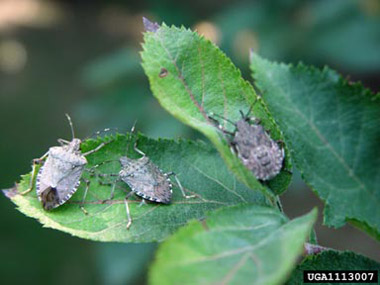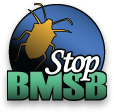Origins of BMSB
 |
| Brown marmorated stink bug (BMSB), Halyomorpha halys (Stål). Photo by Gary Bernon, USDA APHIS, Bugwood.org |
In Asia, people recognized the brown marmorated stink bug (BMSB), Halyomorpha halys (Stål), as a pest. But the insect has not caused nearly as much damage there as it has in North America.
BMSB in Asia
In China, BMSB feeds on Eucommia, a small tree threatened in the wild but cultivated for use in traditional Chinese medicine.[1] BMSB also attacks a variety of fruit and ornamental trees, including pear, peach, apple, plum, and mulberry.[2] In northern Japan, the first documented outbreaks of BMSB occurred in the 1990s; in that region in 2011 the insect had become a significant pest.[3] In Korea, BMSB is a major pest on soybean, sweet persimmon, yuzu, and citrus.[4] Recent research in China, Korea, and Japan has sought to understand the biology of BMSB and find a sustainable and effective defense. Cross-cultural partnership has become essential now that BMSB has arrived in the Americas.
BMSB in North America
BMSB was accidentally imported from Asia to North America in the late 1990s. Spreading from the place of early sightings in Allentown, Pennsylvania, BMSB quickly became a nuisance pest, overwintering in homes, office buildings, and warehouses. With few natural predators and an abundance of food sources, the invasive insect spread quickly. Karen Bernhard collected the first specimens of the insect in North America and in 2001 Rick Hoebeke identified them as BMSB. By 2004 the stink bug was widely identified on farms and in forests. In 2010, the invader caused catastrophic damage in most mid-Atlantic states, with some growers of sweet corn, peppers, tomatoes, apples, and peaches reporting total losses that year. In 2011 the stink bug continued to present season-long and significant problems for growers.
Recent Findings
Recent genetic analysis of BMSB populations from across the globe indicates China as the source of introductions into the US, Canada, and Europe [5, 6, 7]. There is a low genetic diversity of BMSB populations occurring in eastern North America (east of the Mississippi and eastern Canada), and they are likely the result of spread of the population that was introduced into the mid-Atlantic region in the 1990s. Evidence suggests that these individuals originated from an area near Beijing, China. Populations in the western US exhibit greater diversity, suggesting perhaps three separate introductions from China and possibly movement of individuals from the eastern US to the west coast.
In 2012, our team mobilized to develop an effective defense against this pest. Initial efforts were focused on chemical control to provide short-term relief of pest damage. However, considerable progress has been made in understanding BMSB biology and behavior, response to its pheromone, and the role of natural enemies in regulating populations. This research has provided the groundwork necessary to develop more ecologically based, sustainable solutions.
[1] Aijun Zhang, 2011, “Halyomorpha halys in China,” accessed June 5, 2012.
[2] Ibid.
[3] Brent Short and Ken Funayama, 2011, “Kusagikamemushi in Japan,” accessed June 5, 2012.
[4] Yong-Lak Park, 2011, “BMSB in South Korea,” accessed June 5, 2012.
[5] Xu, J., Fonseca, D.M., Hamilton, G.C., Hoelmer, K.A., and Nielsen, A.L. 2014. Tracing the origin of US brown marmorated stink bugs, Halyomorpha halys. Biol. Invasions 16:153–166.
[6] Gariepy, T.D., Haye, T., Fraser, H., and Zhang, J. 2014. Occurrence, genetic diversity, and potential pathways of entry of Halyomorpha halys in newly invaded areas of Canada and Switzerland. J. Pest Sci. 87:17–28.
[7] Valentin, R.E., Nielsen, A.L., Wiman, N.G., Lee, D.-H., Fonseca, D.M. 2017. Global invasion network of the brown marmorated stink bug, Halyomorpha halys. Sci. Rep. 7, Article No. 9866. DOI:10.1038/s41598-017-10315-z
